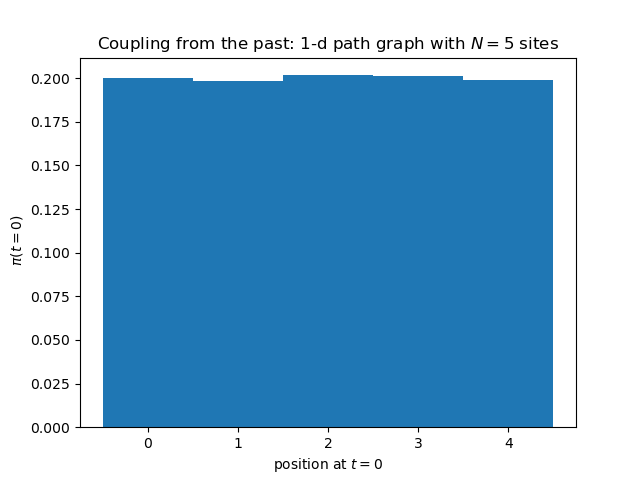SSEPCompact.py
From Werner KRAUTH
(Difference between revisions)
| Revision as of 12:31, 10 June 2024 Werner (Talk | contribs) ← Previous diff |
Revision as of 12:36, 10 June 2024 Werner (Talk | contribs) Next diff → |
||
| Line 1: | Line 1: | ||
| + | ==Context== | ||
| + | This page is part of my [[BegRohu_Lectures_2024|2024 Beg Rohu Lectures]] on "The second Markov chain revolution" at the [https://www.ipht.fr/Meetings/BegRohu2024/index.html Summer School] "Concepts and Methods of Statistical Physics" (3 - 15 June 2024). | ||
| + | |||
| import math | import math | ||
| import random | import random | ||
| Line 33: | Line 36: | ||
| Text = 'Total time = ' + str(prefactor) + ' * N ^ ' + str(exponent) + ' * log N' | Text = 'Total time = ' + str(prefactor) + ' * N ^ ' + str(exponent) + ' * log N' | ||
| print(' ' * (NSites// 2 + 1 - len(Text) // 2) + Text + ' ' * (NSites// 2 + 1 - len(Text) // 2)) | print(' ' * (NSites// 2 + 1 - len(Text) // 2) + Text + ' ' * (NSites// 2 + 1 - len(Text) // 2)) | ||
| + | |||
| + | ==Output== | ||
| + | |||
| + | Here is output of the above Python program. The histogram is absolutely flat, without any corrections. But this is normal, given that the simulation has run, for each of the realizations of the random map, an infinite number of iterations. | ||
| + | |||
| + | [[Image:Backward position t0.png|left|600px|border|Coupling-from-the-past approach to sampling.]] | ||
| + | <br clear="all" /> | ||
| + | |||
| + | ==Further Information== | ||
| + | |||
| + | ==References== | ||
Revision as of 12:36, 10 June 2024
Contents |
Context
This page is part of my 2024 Beg Rohu Lectures on "The second Markov chain revolution" at the Summer School "Concepts and Methods of Statistical Physics" (3 - 15 June 2024).
import math
import random
exponent = 3.0
alpha = 0.5
prefactor = 1.0
NPart = 64; NSites = 2 * NPart
NIter = int(prefactor * NPart ** exponent * math.log(NPart))
NStrob = NIter // 40
Conf = [1] * NPart + [0] * (NSites - NPart)
Active = random.randint (0, NSites - 1)
while Conf[Active] != 1:
Active = random.randint(0, NSites - 1)
Text = 'Periodic SSEP, N= ' + str(NPart) + ', L= ' + str(NSites)
print(' ' * (NSites// 2 + 1 - len(Text) // 2) + Text + ' ' * (NSites// 2 + 1 - len(Text) // 2))
print('-' * (NSites + 2))
for iter in range(NIter):
Active = random.randint (0, NSites - 1)
while Conf[Active] != 1: Active = random.randint(0, NSites - 1)
Step = random.choice([-1,1])
NewActive = (Active + Step) % NSites
if Conf[NewActive] == 0: Conf[Active], Conf[NewActive] = 0, 1
PP = '|'
ktot= 0
for k in range(NSites):
if Conf[k] == 0:
PP += ' '
else:
ktot += 1
if ktot != NPart / 2: PP += 'X'
else: PP += '|'
if iter % NStrob == 0: print(PP)
print('-' * (NSites + 2))
Text = 'Total time = ' + str(prefactor) + ' * N ^ ' + str(exponent) + ' * log N'
print(' ' * (NSites// 2 + 1 - len(Text) // 2) + Text + ' ' * (NSites// 2 + 1 - len(Text) // 2))
Output
Here is output of the above Python program. The histogram is absolutely flat, without any corrections. But this is normal, given that the simulation has run, for each of the realizations of the random map, an infinite number of iterations.

